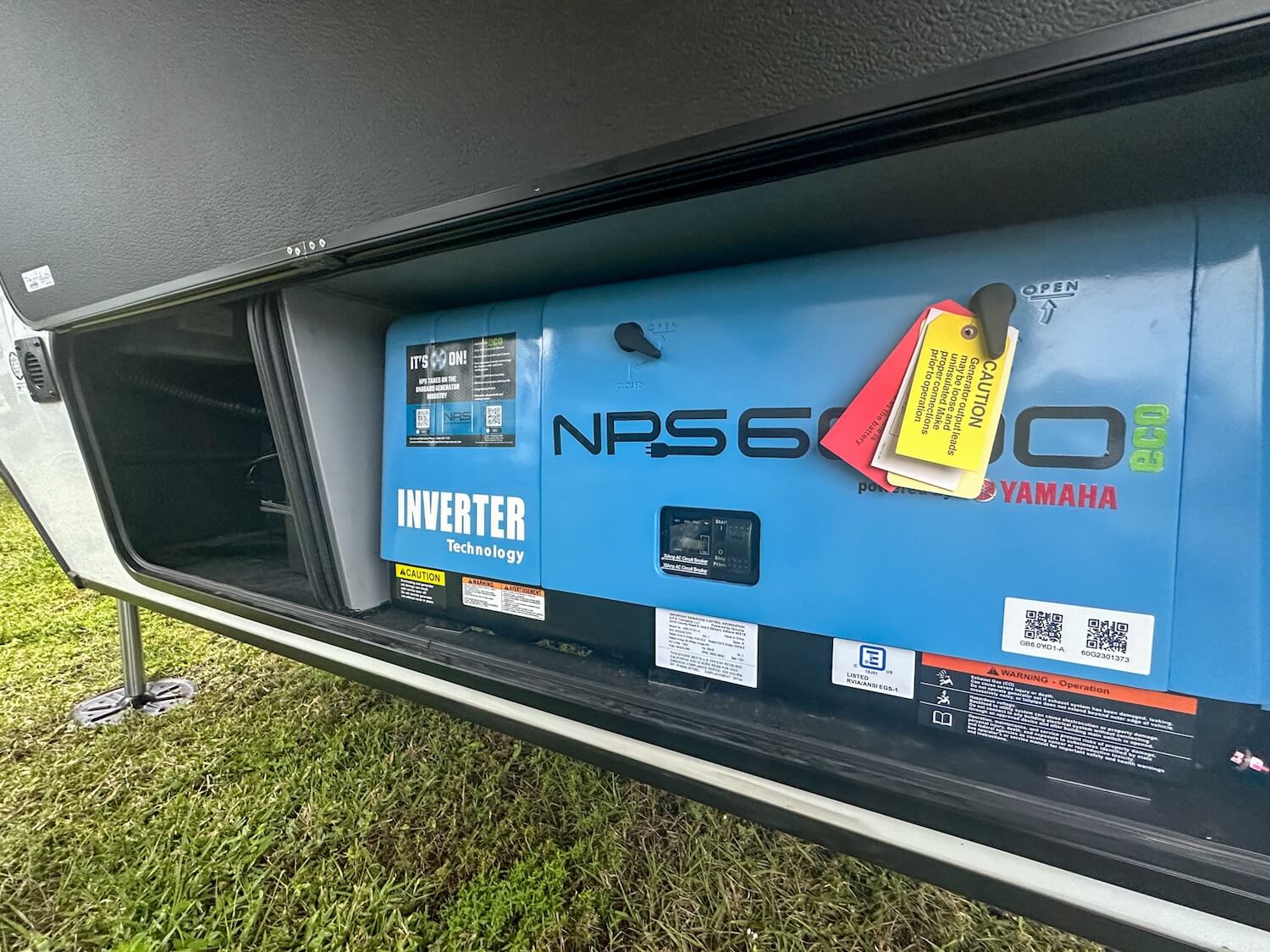How To Use and Preserve an Onboard RV Generator
You’ll discover onboard – also called “built-in” or “everlasting mount” – RV turbines on many motorhomes and a few toy haulers. A generator permits you to take pleasure in extra snug boondocking since you primarily have a built-in solution to generate AC energy.
As a substitute of relying solely in your battery’s storage capability, you’ll be able to fireplace up your generator to ship protected, environment friendly energy to your home equipment whereas recharging your batteries. In case your RV got here geared up with an onboard generator, let’s cowl the fundamentals of learn how to use and keep it correctly:
How To Use an Onboard RV Generator
Picture by Tenting World
For starters, all RV house owners ought to learn their proprietor’s guide for the producer’s really helpful working procedures. For instance, air-cooled turbines should have an entry door in place for correct cooling. Your proprietor’s guide is your greatest useful resource when studying learn how to use your RV’s onboard generator.
Most onboard RV turbines will be began by a button on the unit or a secondary button on a distant management panel contained in the RV. Earlier than you begin your generator, examine that each one home equipment are powered down – particularly giant home equipment like your air conditioner, microwave, and electrical hearth (if geared up).
Relying in your producer’s advice, you could have to prime the generator’s gas system by urgent and holding the cease button for the really helpful interval. To start out your gasoline generator, press and maintain the button. Gasoline RV turbines will instantly crank, however you could want to carry the button for 5-10 seconds till you hear the engine flip over.
Diesel turbines are designed to finish a sequence of inner checks earlier than beginning. You’ll have to proceed to carry the button till it begins. On chilly mornings, your generator might take as much as 30 seconds to start out.
Enable your generator to run for not less than two minutes earlier than inserting it below load (i.e. turning on giant home equipment). The generator will then proceed to run till you utilize the swap to close it down. When able to shut it down, begin by turning off all home equipment. Enable it to run with out a load for 3-5 minutes. Then hit the cease button to energy your generator down.
Suggestions for Good Generator Use
Picture by Tenting World
Constructed-in RV turbines are costly items of apparatus which can be a lot simpler to keep up than to switch. Listed here are a number of suggestions for protected, good generator use:
Run your generator commonly. Most producers advocate working your generator not less than as soon as a month. To train your generator:
Begin it and let it run with out load for 2 minutes.
Run it at 50% load for no less than two hours, both unexpectedly or in two, hour-long periods.
Flip off all home equipment and let it run with out load for 3-5 minutes.
Energy it off.
Keep away from working it for lengthy intervals with out a load.
Make sure the generator’s exhaust pipe extends not less than one inch past the RV’s exterior and is not less than six inches away from any openings. Your generator’s air consumption and discharge have to be free from any blockages.
Examine that the entry door is in place. This have to be ensured when working for cooling functions.
Know the results of altitude. Mills are usually rated at 500 ft of elevation. Energy will lower roughly 3.5% for each 1,000 ft of elevation elevated past that preliminary 500 ft. Take altitude into consideration when calculating the utmost load you’ll be able to place in your generator to keep away from overloading it.
Examine your CO detector. Confirm that the batteries are good and the detector is put in in response to their itemizing. Use the producer’s really helpful protocol to check the unit and guarantee it really works correctly.
How To Preserve an Onboard RV Generator
Picture by Tenting World
Once more, your proprietor’s guide shall be your greatest useful resource. The producer will present service intervals and, in some circumstances, really helpful service procedures for the numerous objects talked about under – and probably others. That mentioned, listed below are a few common suggestions:
Cummins Onan turbines have a reasonably straightforward requirement: the primary oil change is 50 hours for diesel and each 150 hours (or 250 hours for bigger models) or as soon as yearly thereafter.
Gasoline fashions require oil modifications each 150 hours or as soon as per 12 months, whichever comes first.
Along with common oil modifications, listed below are a number of different suggestions for sustaining your onboard RV generator:
Hold the Generator’s Compartment Clear
The much less mud and particles you permit to build up within the generator’s compartment, the much less its air filter might want to work to make sure clear air movement and maintain the engine from overheating – to not point out holding probably damaging particles from stepping into the engine and probably damaging inner elements.
Examine and Clear the Filters Commonly
Most turbines are geared up with an air filter and a gas filter. The gas filter have to be changed in response to the producer’s really helpful interval. The air filter have to be cleaned commonly by tapping it on a flat floor. Keep away from utilizing water or compressed air to wash a generator’s air filter.
Commonly Examine the Exhaust System and Gasoline Traces
Look rigorously for harm and leaks. Use your proprietor’s guide to know what to search for in these checks.
Correct generator upkeep is significant to holding it working effectively to ship protected energy to your RV. Should you want your generator serviced, contact your native Tenting World Service Middle to schedule an appointment.
What questions do you’ve about utilizing and sustaining an onboard RV generator? Tell us within the feedback under.
The post How To Use and Preserve an Onboard RV Generator appeared first on Havens travel and tour blog .




